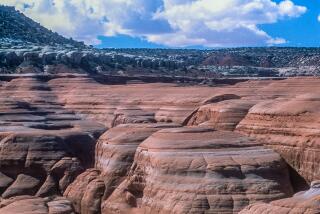Artist Finds Livelihood in Grand Canyon
- Share via
GRAND CANYON NATIONAL PARK, Ariz. — Four million visitors a year come to Grand Canyon National Park. Only a relative handful will ever meet Bruce Aiken. But nearly every one of them owes a debt to the National Park Service employee who for more than a quarter of a century has made it possible for them to brush their teeth and flush their toilets in their hotel rooms on the north and south rims of the mighty canyon.
Aiken, who came to the Southwest from New York in 1972 in search of a place to fire his artist’s imagination, runs the pump house at a place called Roaring Springs, 5.5 miles down the North Kaibab Trail from the north rim of the canyon. He’s in charge of supplying all the water for one of America’s premier tourist destinations from a natural spring that gushes from a rock face.
The pumps he maintains send 115 gallons a minute to the north rim, and the trans-canyon pipeline he oversees sends another 800 gallons a minute on a gravity journey across the canyon to Indian Gardens on the south side, where another pump pushes it to the top.
Keeping the Grand Canyon supplied with water during the tourist season means that for eight months a year, Aiken and his wife, Mary, live in a small house deep inside the canyon, some 4,000 vertical feet below the rim.
Their groceries come about once a month via the helicopter that takes out water samples for testing. If they run short of sugar or beer, they do without or go for an arduous walk of about 12 miles round trip to the store.
Their three children grew up here, schooled at home and in a wondrous place that writer Colin Fletcher called a “huge natural museum of the earth’s history.” Their children’s lemonade stand on the North Kaibab Trail--where summertime temperatures of 110 are not unusual--may have been the most welcome back-country oasis in North America.
They have no television. They have no neighbors other than the steady stream of hikers coming by their front gate, some doing a nearly 25-mile “rim-to-rim” jaunt.
Aiken, 49, wouldn’t live any other way. Asked why he chooses to remain in a place so far removed from late 20th century amenities such as the new “Star Wars” movie, he turns the question around and makes a visitor wonder why he’s living surrounded by civilization.
“Why would I ever want to go breathe polluted air?” Aiken asks. “Why would I want to fight traffic? Why would I want to look at ugly shopping malls and generic neighborhoods when I can look at this? Why would I want to lead a sedentary life when I can hike in and out of the Grand Canyon? This place is beautiful. It makes you feel good just to live here.”
And it’s a fabulous place to practice his real love, painting. On large canvases, and usually in oil, Aiken uses vivid colors and “lots of strong light” to capture what may be America’s greatest landscape in a style that has been called “authoritative realism.”
Aiken is definitely not in the starving-artist category. He is well known enough that he no longer has to sell through galleries, and there is usually a waiting list of around 18 months for the seven or eight paintings he completes each year. Some of his clients discover his work at the grand El Tovar hotel on the South Rim; others stumble across him and his talent while hiking past Roaring Springs.
Most of the time, Aiken’s work on the water system and the two 150-horsepower plunger pumps is routine. He lubricates the pumps, checks the bearing temperatures, checks the auto oiler and samples the water for pH, turbidity, chlorine and temperature.
But there are times when landslides or flash floods take out parts of the pipeline, and Aiken and other park service employees have to rappel off sheer cliffs to make repairs.
It’s a long way from his Greenwich Village boyhood and the Art Students’ League in New York. But when Aiken came here in the early 1970s, he knew he’d found home. He worked first on the trail crew at Grand Canyon National Park, then took over the pump house in 1973 when the previous operator retired.
“I was looking for a place to paint,” he recalls. “I was in New York making up these landscapes, and then I came to Arizona and said, “I’m never leaving.’ ”
More to Read
Sign up for The Wild
We’ll help you find the best places to hike, bike and run, as well as the perfect silent spots for meditation and yoga.
You may occasionally receive promotional content from the Los Angeles Times.






